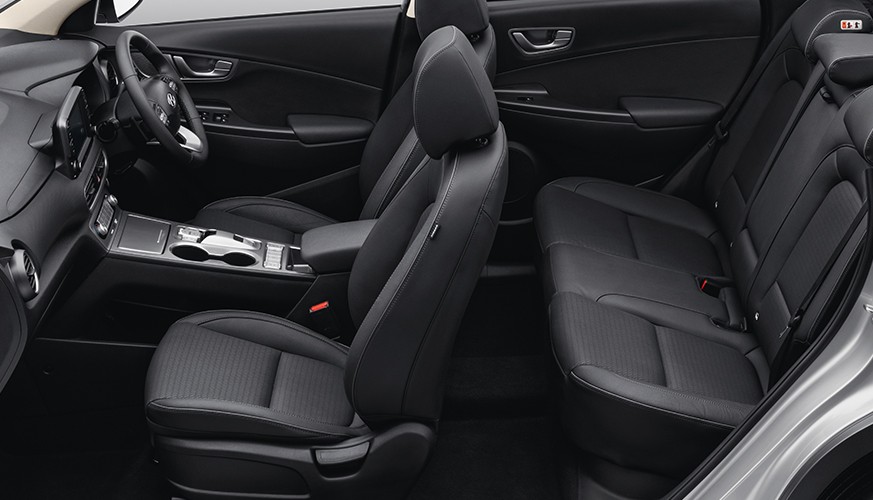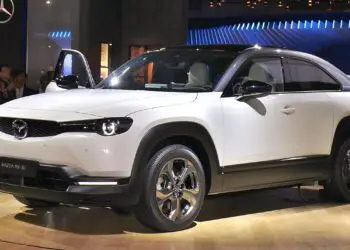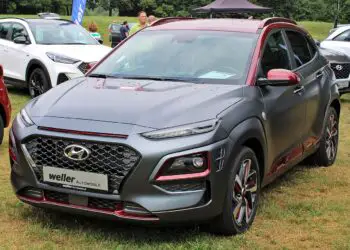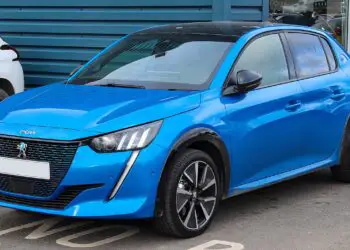Here we brought you the Hyundai Kona Electric review. If you want somebody to try something new, it helps to make him feel like it’s something they’ve already experienced. that kind of familiarity breeds comfort and I definitely think that’s the case with EVs.
Now I’m not really talking about the early adopters the people who need to be at the cutting edge attack. I’m referring more to the hoi polloi the average Joe’s and Jane’s of the world. That’s why I am such a fan of this subcompact Hyundai Kona EV. Electric, it takes all the good parts of the Kona that I drove last year and translates it to an electric vehicle that should appeal to both tech nerds and my mom.
Overview
The best part is not a whole lot has changed since the gas version. There are of course some distinct design differences between this Kona electric and the regular gas version. Even though the two are pretty similar. Upfront the grille has been eliminated and replaced with this kind of dimpled front-end that adds some character – believe it or not probably the one car that doesn’t actually need extra character. It also has a set of wheels that well I absolutely adore. But honestly, most folks might have trouble differentiating this from any other Kona. Again I think that’s a pretty good thing.
The electric powertrain means the interior gets a shakeup too. The tall center console has been swapped out in favor of one, that has a surprisingly large cubby underneath with both the USB and a 12-volt charging port. The standard shift lever is gone. In favor of a button cluster that to be honest, I still haven’t been able to commit to muscle memory even after a week of regular use. Ahead of that is yet another deep cubby with enough space for a wireless device charger.
Interior

Personally, I would stick with the dark interior option because all this brightwork in my tester makes the car look a little cheap. Hyundai Kona’s battery doesn’t eat in the cargo space. Thankfully because it’s 19 cubic foot cargo capacity is second to last in the segment. that being said there is still plenty of space in the cabin for humans or dogs or cargo you put in the second row. I don’t know what you people do with your cars. sadly there is no frunk just a bunch of EV hardware tucked under the hood.
Performance
The Kona Electric rocks a single electric motor tied to its front axle that puts out 201 horsepower and 291-pound feet of torque. Now for those of you keeping track at home that’s 26 horses and 96 torques more than even the high output motor on the gas version of Hyundai Kona. The best part about it is you can feel it all the time. No matter what speed you’re going use to smash the gas a little bit and you get a nice smooth wave of torque.
When it comes time to stop there is a three-stage regenerative braking system that gives you different strengths upon deceleration. adjustable through the two flappy paddles on the back of the wheel. now if you’re more fan of the one-pedal driving scenario. Don’t worry, the Kona electric does have you covered all you have to do is upon deceleration hold the left paddle here and it’ll bring in nicely to all now.
Suspension

In terms of suspension quality and noise mitigation, the story is a little less positive. Sadly, the suspension is fine but it rides really rough shot over prominent bumps and dips which is kind of a bummer. Then there’s noise mitigation there doesn’t appear to be much of bad at all. As a matter of fact, it’s much louder than the gas Hyundai Kona. Because at least the gas Kona had the engine trying to counteract the road noise whereas here. This thing has brought an entirely silent. So all I hear is road noise that being said. There is a low-speed EV noise that kind delicious.
Efficiency
That now in terms of efficiency, the EPA rates this battery at 258 miles for a full charge which is about four miles per kilowatt-hour. Thankfully Michigan’s weather has been a little better than usual about 40 degrees. So I’ve been slower than that but not to load about 228 miles per charge or about 3.6 miles per kilowatt-hour. Now I’ve been driving this car just as normally as I do any other car I’m trying not to pretend it’s being super-efficient or anything and I usually get somewhere between three-point eight and four-point six miles per kilowatt-hours.
So I will say that the EPA numbers aren’t obscene and they seem pretty easily reachable now in terms of charging when you finally deplete your battery this will take about nine hours to fill up on the standard 240-volt setup. But thankfully there is DC fast charging pad ability so if you’re out on the town you can get up to 80 percent of your battery life and just about under an hour.
Technology
Now in terms of in-car tech. Hyundai Kona Electric isn’t all that different from the regular gas Kona. My ultimate trim tester gets an 8″ touchscreen infotainment system with navigation and an apple car play Android auto satellite radio the whole nine-yards. This system is a couple of years old at this point, but we still love it because it’s responsive and it’s always worked well for us. On top of that my tester also receives a retractable head-up display activated by a button on the side. But it is a little low to the dashboard because it uses its own backer which makes it kind of awkward for taller drivers.
Safety
Now unlike some other electric vehicles, the Hyundai Kona electric actually comes with a surprising amount of standard safety systems. I mean even on the base tester you get things like Auto break Lane keep assist and blind-spot monitoring. Here on my top trim testers, all that stuff is wrapped up and it’s added to with both pedestrian detection and adaptive cruise control with stop and go functionality. It all works pretty well I mean the lane keep assist can be a little heavy-handed both on the road and the highway but. Otherwise smooth as butter.
Affordability
The standard Hyundai Kona (The gas version) is a pretty affordable car the Hyundai Kona Electric on the other hand not so much. The base model rings in at thirty-six thousand four fifty before incentives and destination. While my ultimate trim tester clocks in at a lofty forty-four thousand six hundred and fifty bucks. now that might seem like a lot of scratches but it is pretty much in line with the competition.
The Nissan Leaf plus is similarly priced but you get a little less range and the text nod is impressive. and the Chevrolet bolt TV is also up there but its equipment packaging is trash compared to Hyundai’s democratized way of doing things. As for Tesla’s model Y well it doesn’t exist yet. So the Hyundai Kona electric more or less checks all my boxes. It’s pretty much a normal car with a stout electric motor and a capacious battery, which means I think it’ll go over pretty well with the public.
Engine Specification
| Specification | Items | KONA Electric |
|---|---|---|
| DIMENSIONS | Overall Length (mm) | 4,180 |
| DIMENSIONS | Overall Width (mm) | 1,800 |
| DIMENSIONS | Overall Height (mm) | 1,570* |
| DIMENSIONS | Wheelbase (mm) | 2,600 |
| ELECTRIC MOTOR | Electric Motor Type | Permanent Magnet Synchronous Motor (PMSM) |
| ELECTRIC MOTOR | Max Power (ps) | 136 |
| ELECTRIC MOTOR | Max Torque (kgm) | 40.27 |
| HIGH VOLTAGE BATTERY & CHARGING | TYPE | Lithium-ion Polymer |
| HIGH VOLTAGE BATTERY & CHARGING | Capacity (kWh) | 39.2 |
| HIGH VOLTAGE BATTERY & CHARGING | AC Charging (0-100%)** | Approx 6 h 10 min |
| HIGH VOLTAGE BATTERY & CHARGING | DC Charging (0-80%) @50 kW** | Approx 57 min |
| AUTOMATIC TRANSMISSION | TYPE | Single Speed Reduction Gear |
| SUSPENSION | Front | Mcpherson Strut Type |
| SUSPENSION | Rear | Multi – Link |
| BRAKES | Front | Disc |
| BRAKES | Rear | Disc |
| TYRE | Tyre Size | 215/ 55 R17 Alloy Wheel |
| TYRE | Emergency Spare Tyre | T135/80 D17 |
*with Roof Rails
**Note : Depending on the condition of high voltage battery, charger specifications, and ambient temperature, the time required for charging the high voltage battery may vary.
The Review
Hyundai Kona Electric
PROS
- Powerful Motor Performance
- Impressive Driving Range
- Advanced Safety System
- Professional Interior
CONS
- Low Suspension



